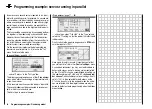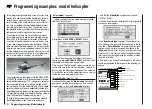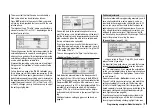
92
Controlling the electric motor and butterfl y (crow) system using the C1 stick
(Butterfl y / crow system as landing aid: ailerons up, fl aps down)
Example 4
Before we start the programming of this fourth example,
and turn our attention to expanding the basic program-
ming we have already discussed, we need to consider
briefl y the position of the throttle / brake stick at “motor
OFF” or “brake OFF”. Usually the C1 stick is moved for-
ward to open the throttle, and back to extend the brakes.
However, if you adopt this “classic” confi guration, and
switch, say, from “motor OFF” (stick “back”) to the bra-
king system, “full brake” would immediately be applied,
and vice versa: if you switch from “brakes retracted” to
power, this would instantly switch to “full power”.
These inter-connected effects are defi nitely not desi-
rable, and to avoid them we recommend that you posi-
tion the “zero point” of both systems so that they coinci-
de. With the mx-16s system the offset point of the fi xed-
wing mixer “Brake
NN” (this mixer is also required),
is fi xed at “stick forward”, so the following programming
example shows how to position “motor OFF” and “brake
OFF” together, at “front”.
In the menu …
»Base settings«
(page 38 ... 41)
leave the “
motor at C1
” line at “none”, or change to
this setting if necessary. This is essential, otherwise the
“
Brake 1
NN
” mixers which we need will be sup-
pressed in the »
Wing mixers
« menu.
Important note:
As it is essential to set the motor to “none”, this also
automatically disables the “Throttle too high” power-
on warning! For this reason please take great care
to set the C1 stick to the correct position before you
switch on the receiving system.
The next step is to ensure that the motor is switched off
“forward”, and is switched on when the C1 stick is mo-
ved “back”, i.e. towards the pilot’s body.
To achieve this you may have to move to the menu …
»Servo settings«
(page 48)
and reverse the direction of servo 1.
For safety’s sake you should check this setting now, be-
fore you continue with the programming procedure.
Take the transmitter and model to a location where it
is safe to run the motor. Switch the transmitter on, and
move the C1 stick fully forward. Hold your model fi rmly,
or ask a friend to hold it for you. Check that the propel-
ler is free to rotate without causing havoc, then prepare
your model for use.
If the motor does not run in the “stick forward” position,
everything is in order. However, check the system any-
way by gradually moving the stick back towards you until
the motor begins to run. Stop the motor, then switch off
the receiving system in the model and fi nally switch off
the transmitter.
Note:
If the motor does not start, or spins in the wrong direc-
tion, there are other problems which you must correct
before you resume programming. For example, check
the wiring of your motor, and refer to the operating in-
structions supplied with your speed controller.
Once you are confi dent that the direction of the C1 stick
is “correct” as far as the motor is concerned, the next
step is to ensure that its effect on the motor can be swit-
ched on and off, so that you can also control the braking
system. This is carried out in the menu …
»Free mixers«
(page 77 ... 80)
… where you need to program a free mixer “C1
C1”.
When you have done this, move to the
(switch) co-
lumn and assign your selected “change-over switch” to
this mixer; for example SW 1. This is done by activating
the switch assignment with a brief press on
SELECT
,
and moving the switch from “forward” to “back”, i.e. to-
wards you.
With the mixer switched on, move to the second screen
page, and there set a starting point of -100% for the
SYM
metrical mixer value.
Now hold the
SELECT
button pressed in, and use the
right-hand rocker button to move to the “Offs” line. The
Programming examples: Fixed-wing model
Содержание MX-16S
Страница 1: ...1...
Страница 17: ...17...
Страница 31: ...31 Fixed wing models Installation and connections...
Страница 35: ...35 Program description Reserving a new memory...
Страница 47: ...47 Base settings Model helicopter...
Страница 83: ...83 Fail safe...
Страница 89: ...89 Programming examples Fixed wing model...
Страница 109: ...109 Programming examples Model helicopter...
Страница 112: ...112 112...
Страница 116: ...116...
















































